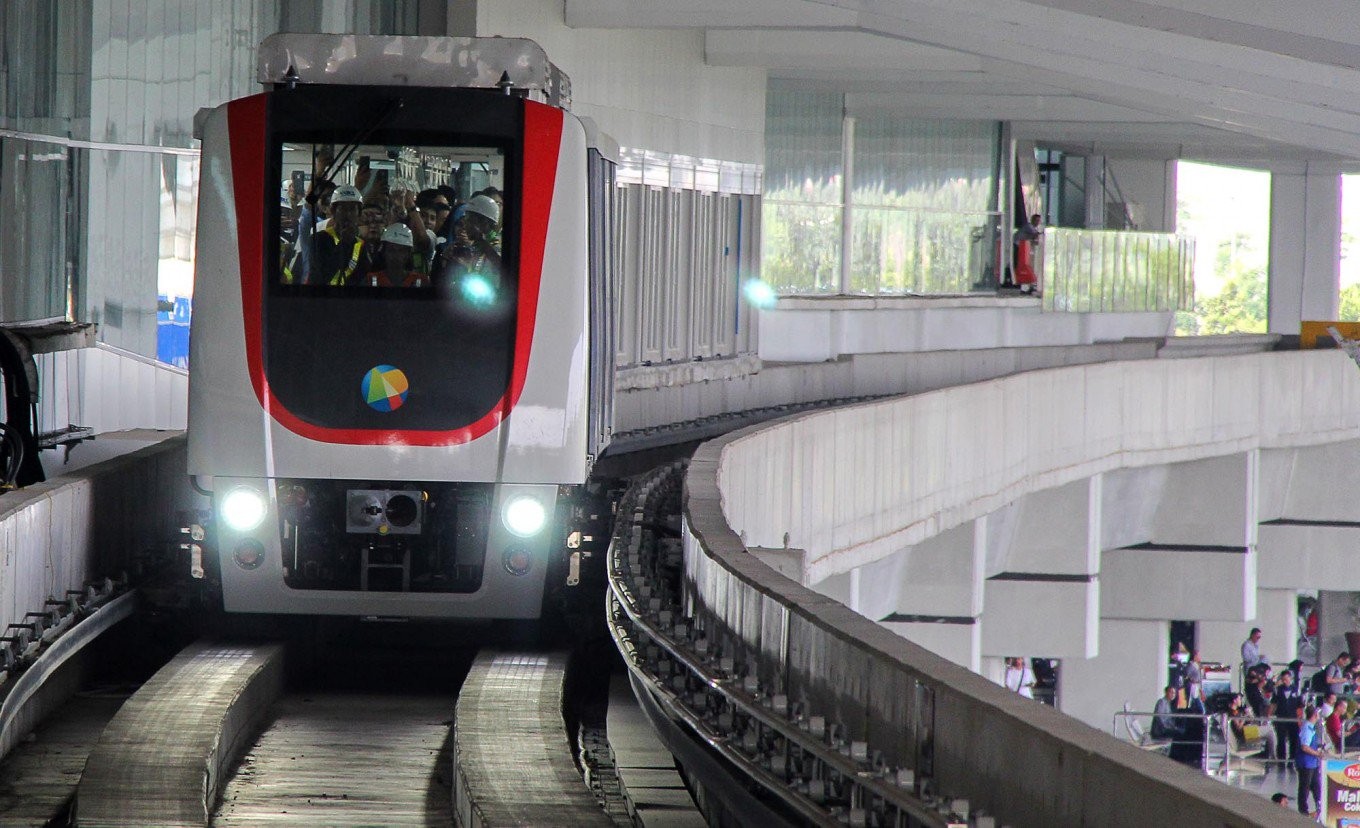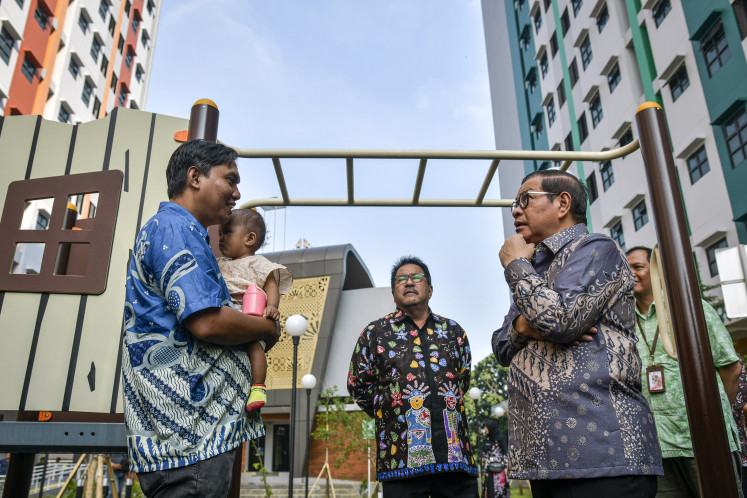Popular Reads
Top Results
Can't find what you're looking for?
View all search resultsPopular Reads
Top Results
Can't find what you're looking for?
View all search resultsAfter one year: Improving international airport train
According to PT Railink, average occupancy is only at 30 percent of the total capacity, meaning that the train carries fewer than 80 passengers per journey.
Change text size
Gift Premium Articles
to Anyone
L
ast Dec. 26 marked one year since the opening of Railink, a dedicated railway system connecting Soekarno-Hatta International Airport and Jakarta. It showed up as an alternative mode to reach the airport. Launched by PT Kereta Api Indonesia (PT KAI), it is currently operated by PT Railink, a joint venture between PT KAI and PT Angkasa Pura II, the airport operator.
After the hype during its opening months, the popularity of this Rp 3.7 trillion (US$260 million) investment seems to be slowly evaporating. According to PT Railink, average occupancy is only at 30 percent of the total capacity, meaning that the train carries fewer than 80 passengers per journey. Apart from travelers, the passenger profile also includes airport staff, passenger greeters and well-wishers.
Railink’s capacity has been improved over the year. So far, with the six-car Bombardier EA203 type, it can accommodate 272 seating passengers in one go. With a frequency of every 30 minutes, the maximum number of passengers per hour per direction (pphpd) touches 544. Even though this number is relatively low compared to other airport links, for example the KLIA (Kuala Lumpur International Airport) Express in Malaysia (624 pphpd), the Airport Express in Hong Kong (6,216 pphpd), the AREX Express Incheon in South Korea (1,824 pphpd) or the Heathrow Express in London (1,360 pphpd), it can potentially significantly reduce congestion on the airport spine road.
If we assume 70 percent occupancy on every journey, Railink could capture 23,610 passengers per day or 8.6 million per year, not including non-passenger riders and peak hour passengers.
If the total number of origin-destination passengers at Soekarno-Hatta is 85 percent of 63 million annual passengers, Railink could provide a 16 percent share of transportation to and from the airport — far better than the current share of around 5 to 7 percent. Thus the train capacity is sufficient, but Railink’s share is unfortunately still below the line.
Globally, the average market share for train riders to the airport is 20 percent. In Europe, however, the share is slightly higher at 27 percent, owing to transformation in European cities where airport stations have become the cities’ intermodal hubs, such as the Netherlands’ Amsterdam Airport Schiphol, Germany’s Frankfurt Airport and Switzerland’s Zurich Airport. Asian cities should be glad enough with the average of 21 percent market share. Price and geographical location have influenced this achievement.
Despite being the fastest option in Hong Kong, for example, the Airport Express is still struggling to compete with the city’s airport buses. In 2017, the Airport Express’ market share compared to other public transportation was only 21.3 percent, while airport buses had almost double that figure. The main reasons for customers choosing buses instead of the Airport Express are price and the ability to travel directly to specific destinations.
Contrary to assumptions that potential passengers of Railink are put off by the fare, this would not be the main reason for its underperformance. Railink offers a competitive price of Rp 70,000 for a one-way journey. The government’s Damri bus costs Rp 40,000 between the airport and Gambir station, making Railink 75 percent more expensive.
In Hong Kong, a one-way journey on the Airport Express is HK$115 (US$14.67), 155 percent higher than the average airport bus fare of around $40-$50. Other extreme examples are the Shanghai Maglev, which charges 600 percent more than normal metro line to Longyang road station and the KLIA Express, which costs 55 Malaysian ringgit (US$13.37), 450 percent more expensive than airport buses that cost just10 Malaysian ringgit.
However, journey time is also a crucial consideration. The more expensive price of airport links could be worth 3 to 8 times extra speed compared to slower modes of transportation. Even though Railink offers a fixed duration of 46 minutes, it has yet to reach the abovementioned range. Further, passengers not only consider train speed, but also getting to the station, which brings us to the biggest concern and gap: connectivity.
Airport trains typically connect main transport hubs in the city to airport terminals or their ground transportation center (GTC). The Airport Express in Hong Kong connects Hong Kong International Airport at the arrival level with the island’s main Central station, where passengers have other options to change to the bus, metro or ferry.
The Airport Express also stops at Kowloon station, which has been recently opened as a High Speed Train station to mainland China. In Kuala Lumpur, the KLIA Express brings passengers from main terminals to KL Sentral, the city’s main intermodal hub. From here, passengers can choose the LRT, bus or intercity train.
Railink, however, attempts to connect Jakarta city center and the airport. But the key to minimizing walking distance and level changes between transport modes is still missing. At the airport, Railink train stations are not connected to any of the three terminals. Instead, air passengers are required to change to the “airport people mover” (APM) or Skytrain, to reach the closest APM station to terminal buildings. Ironically, from here, air passengers still cannot yet reach either the departure or arrival level. Worse, from APM Terminal 1 and 2 stations, air passengers have to cross the road (terminal’s arrival kerb), risking their safety.
Similar concerns surround the city’s station. The current main Railink station, Sudirman (BNI City) still lacks intermodal connectivity. Hence, without knowing its expansion plans, the presence of this station feels like a random decision.
Manggarai and Bekasi stations offer better intermodality to the commuter train lines, but it is still not the best option particularly for non-Jakartans less familiar with the city. Unfortunately, due to existing capacity and the security system at Gambir station, Railink has not yet picked up travelers from here, leaving the biggest potential source of passengers: those coming from other cities on the regional KAI trains.
To improve performance, Railink would need to focus on improving current operation and planning of future connectivity — both physical and non-physical. Other airport links have expanded services beyond physical connection, such as remote check-in, integrated booking and luggage handling as part of integration between transport modes. This of course requires cooperation between stakeholders.
Finally, since the planning of the airport train involves airport knowledge, PT Railink, PT Angkasa Pura II, PT KAI and the government bodies should not only collaborate with, but also hire experts of airport planning and infrastructure that understand both city and airport strategies through their best practices to unlock the vast potential of Indonesian airports.
***
The writer is an airport and urban planner at Netherlands Airport Consultants / Royal Haskoning DHV, Delft University of Technology, The Netherlands.











